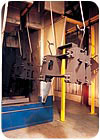Energy-Saving Strategies for Curing

Lowering oven temperature is not always the best way to reduce the cost of energy used for curing coatings. Many modifications can be made to the finishing process, oven maintenance procedures and the oven itself to save money without sacrificing finish quality.
With natural gas costs increasing to a recent average of about $8.75 per 1,000 cubic feet ($0.875 per therm), finishers are looking for ways to reduce energy consumption and operating costs. The curing oven is one of the first places to start.
Older curing ovens may not be designed for optimal efficiency. Typically, burners and exhaust fans in these ovens are larger than necessary, and their insulated panels could be more efficient. In today's environment, it may make sense to invest in a new, more energy efficient curing oven. But even ovens constructed just a few years ago may not be operating at peak efficiency, adding to operating costs, jeopardizing cure and increasing energy consumption.
Many finishers believe the easiest way to save energy is to lower the temperature of the oven. While this solution does save fuel, a lower oven temperature might not allow sufficient curing of the paint film, which will affect the coating's physical and performance properties. There are other changes that can be implemented to save energy.
Measuring Baseline Oven Temperature
To understand the impact adjustments have on the curing process, it is important to establish some baselines for current oven operation, starting with a temperature profile of the oven. The smoke charts of the past have been replaced with data loggers that gather and store air and part temperatures at different positions while moving through the oven.When establishing baselines, the temperature profile for both light and heavy part thicknesses should be tracked, because the heavier sections absorb heat at a slower rate and can take a longer time to reach cure temperature. The air temperature in the oven also should be measured at two or three vertical levels (the bottom, middle and top of the parts).
Once baseline oven temperatures have been determined, they can be used to track the effects that mechanical changes to the oven have on energy consumption.
Let's take a look at some ways energy loss can be prevented with a bake oven, and some mistakes to avoid. This list is not in any order of significance, nor is it all-inclusive. The savings associated with each adjustment depend on several variables, and as such, will produce different results in different situations. When testing, use a gas meter in addition to the data logger to measure only the energy consumed by the oven/cure process. Also, make only one adjustment at a time so that its effect can be isolated and compared to baseline data.
Potential Changes
1. Adjust exhaust and purge fans. Many coatings release solvents or volatile organic compounds (VOCs) during curing. The amount of release should be obtained from the coating supplier and compared to the oven's exhaust rate, adjusted for temperature.For example, four gallons of paint are reduced with solvent and applied in about 60 minutes. The amount of solvent in the applied coating is at the 50% level, so two gallons of solvent enter the oven within the 60-minute period. Based on the National Fire Protection Association (NFPA) requirement for maintaining a 25% LEL (where a typical solvent will render approximately 2,500 cubic feet barely explosive), approximately 10,000 standard cubic feet (scf) of air at 70°F should be exhausted for every gallon of solvent entering the oven. In this example, two gallons of solvent enter the oven in one hour, so 2 x 10,000 = 20,000 scf per hour. Dividing this amount by 60 minutes indicates that 333 cubic feet of air at 70°F are exhausted per minute.*
Since air expands when heated, the exhaust fan would be sized for the 333 cubic feet per minute volume corrected for the temperature rise in the oven. The volume at oven temperature is found by multiplying the oven temperature converted to Rankin degrees (obtained by adding the temperature in Fahrenheit degrees to 460) by the volume of air at 70°F, and then dividing that number by 70°F converted to Rankin degrees. In this example, the calculation would be:
(400 + 460) x 333 cfm/(70 + 460) = 540 cubic feet of air per minute at 400°F.
Sometimes it is advisable to provide more exhaust than actually needed to prevent the solvents and burner combustion products from fouling the oven atmosphere, but the exhaust fan should not be so far oversized that it wastes energy.
The purge fan is a separate fan that operates in conjunction with the exhaust fan to purge the oven prior to ignition of the burner. After the burner ignites, the purge fan should be shut down until the next oven startup.
If coating changes have been made, adjust the exhaust requirements based on the new loading. In some instances, exhaust rates may be at levels required for low solids coatings, even though high solids or waterborne coatings are now being used. Remember that the exhaust must be sufficient to remove both solvents and burner combustion products.
2. Determine the optimum conveyor, hook/hanger and part load. Measure the exit temperature of the coated parts, as well as hooks and hangers. This measurement can be accomplished with an infrared thermal device. Where possible, change hanger designs to reduce weight yet maintain the load carrying capacity. The lower mass will rob less energy from the oven.
3. Add air seals. Review the part entry and exit to the oven. If a side entry is used, consider installing a circulated air seal at each opening to retain oven heat. Air seals keep cold air from entering the oven part openings and also keep hot air from exiting through the openings. Circulated air seals trap heat within the oven, maintaining peak temperatures during most of the parts' travel through the oven. This solution can result in a longer dwell time at the peak temperature, keeping heat loss to a minimum while increasing oven operating efficiency and reducing the ambient temperature adjacent to the oven entrance and exit. The increase in time at this higher temperature can be retained to increase the degree of cure. Alternately, the oven temperature can be lowered for a given line speed, reducing the energy consumed, or the oven can be used to provide cure at an elevated line speed, increasing production throughput without increasing energy consumption. It is possible for air seals to save up to 90% of the energy that might otherwise be lost through these openings.
4. Reduce oven silhouette openings to reduce heat loss. The part package should be reviewed and compacted if possible. Care should be taken to retain part orientations for proper spraying.
5. Consider adding more insulation to the exterior of the oven. Doing so may not only save energy, but also improve worker comfort and safety since the exterior wall temperature of some ovens is high enough to cause bodily harm to personnel. Added insulation also can reduce the potential for fires in the area. With increased line speeds and part loadings over the years, some oven temperatures have been driven beyond design limits, resulting in heat loss through the oven's exterior panels. The energy savings often outweighs the cost of the added insulation.
6. Review the operation of the burner(s) used to heat the oven. Inspect and clean the burners as needed, and check the condition, quality and color of the flame. Check for the completeness of combustion throughout the burners' operating range. Replace the filter on the combustion air supply to the oven to provide the needed amount of clean air to the system.
7. Evaluate the entire heat load of the oven. Compare the load based on the design specifications required for current operating conditions (oven temperature, quantity of coatings used per hour, solvent loading, ware and conveyor loading, etc.). Determine whether the burner is larger than needed and whether it can cool quickly enough during a line stoppage to prevent damage to the coating. Older ovens may have oversized burners that consume more energy than necessary and require greater exhaust fan capacities.
8. Consider using catalytic infrared elements to supplement the heat in the oven. The elements can be placed at the oven exit and can heat the parts with infrared energy while also burning hydrocarbons from the solvents in the coatings. The infrared may allow for the needed level of cure without increasing the oven temperature.
9. Optimize fan rotation. Measure the current draw or amperage needed to determine the power consumed by the fan motor. If the motor is not running at capacity, it may be possible to increase the fan rotation to provide additional air for circulation throughout the oven. This can be accomplished by changing the sheave and belt(s). The added circulation may provide improved heat transfer.
10. Use waste heat from the washer, dry-off oven or boiler to preheat air entering the oven or finishing room. Use an air-to-liquid and a liquid-to-air combination of exchangers to safely transfer the heat.
11. Optimize line/load density. Line/load density is the number of parts/components on the conveyor line during normal operation. Production lines may be run faster than needed to provide the required number of parts per shift. An improvement in the load density will place more parts in the same space. Slower line speeds could be used. Providing the same level of production at lower line speeds and shorter operating times can save energy because the equipment could be operated for a shorter time period during each shift.
12. Consider increasing the circulation rate of the air in the oven beyond the small increase for the given fan capacity. The air circulated within the oven brings the cooler air in the main chamber through the heater house, past the burner, through the distribution ducts into the oven again. The more uniform the air within the oven, the more consistent the cure. When increasing air circulation rates, the parts must be fixtured so that increased air movement will not knock them from the conveyor line. Circulation rates can range from slightly above zero oven volume turns to about 10 turns or more to improve the transfer of heat, the rate of solvent or water evaporation, and the rate at which the part temperature rises, but the cost and requirements for circulating 10 oven volumes of air can be prohibitive. Also, most oven ducting is not sized to handle velocities that are that high. Cost constraints limit oven manufacturers to duct sizes and materials to handle linear velocities at 3,000 feet per minute (fpm) or less. When velocities exceed the 3,500 fpm range, duct materials must be increased to handle the added mechanical stress. A typical convection air oven has a circulation rate of three to four oven volumes per minute to stay under the 3,500 fpm range.
13. Clean ovens regularly and thoroughly. A drawback of a higher rate of air circulation within the oven is the potential for blowing dirt. Dirt blown onto parts can be a source of part rejections or reworks - neither of which is energy- or cost-efficient. Ovens should be cleaned on a routine basis. Shovels and brooms are not the proper tools to use, nor are shop vacuums. Only clean room type vacuum cleaners and tools should be brought into the oven to minimize the amount of dirt returned to the oven. All surfaces should be cleaned, including conveyor rails, turns and sanitary (dust/dirt pans), fans, interior and exterior ducts, and the burner and interior of the heater house.
14. Inspect ovens routinely. Any unnecessary opening should be closed to prevent heat loss. Once the circulation rate and air distribution are established, then the dampers on the supply ducts should be secured in place. The discharge dampers provide even movement of the air within the oven to prevent cold spots and provide the temperature consistency needed to establish the desired level of cure. The position of the dampers can change due to part fall-off and personnel movement. The condition of the distribution ducts also should be inspected routinely. In some cases the supply ducts are located on the ceiling or floor of the oven. In a very tall oven, additional ducting may be needed halfway between the oven floor and ceiling. Occasionally, some ovens use a network of return air ducts that bring the cooler air in the oven chamber back to the heater house for reheating. The return duct network can help provide a more uniform temperature throughout the oven by returning the air from the entire oven, and not just the point closest to the circulation fan intake.
15. Use the proper conveyor lubricants for the chain, trolleys, roller and wheel turns within the oven. Some high-temperature lubricants might not be resistant to the oven temperatures achieved in a given application. To test a lubricant, place a sample in the oven at the same temperature as the main bake or dry-off and leave it in the oven for the same amount of time that the conveyor is in the oven during production. At the end of the evaluation period, remove the sample from the oven and examine it. If the lubricant is dried out, hard or otherwise changed in state, it should be replaced with a material that will maintain its properties at the required temperatures.
16. Eliminate common or combined ovens used for both part dry-off after cleaning and for paint curing. These ovens should be separated and independently controlled and heated. Often, energy is wasted because parts are dried at curing temperatures that may be much higher than needed for drying water. Separating the dry-off oven from the cure oven also may reduce humidity within the cure oven. Humidity can impede coating cure.
17. Use an air blow-off to remove excess water and puddle water from parts exiting the washer. This action will allow for lower dry-off oven temperatures.
18. To lower the cure temperature, select catalysts that do not affect the conductivity of the coating. Especially for electrostatic applications, the change will affect the way the coating applies.
19. To lower the cure temperature, don't use catalysts that can jeopardize film properties. The resultant film changes may prevent the coating from meeting required specifications.
20. Consider using coatings with less solvent, such as high solids or waterborne coatings, to coat the parts. Look into coatings specifically designed for lower bake temperatures and VOC emissions. Weigh the energy savings against the added costs associated with the coatings under review.

Optimized Cure
In addition to the energy saving strategies provided here, other energy saving techniques also can be considered to reduce costs and save energy. The impact of changes always should be compared to current energy consumption and costs, and any potential effects on the products being cured should also be evaluated. With the right adjustments, finishing managers can achieve a substantial savings in energy consumption, along with an optimized cure.FOOTNOTE:
*Note: The 70°F reference is the standard temperature used by the NFPA. Other standards exist, depending on the industry, so care must be taken when selecting and referencing the standard conditions.
Looking for a reprint of this article?
From high-res PDFs to custom plaques, order your copy today!





